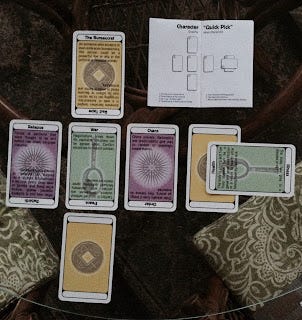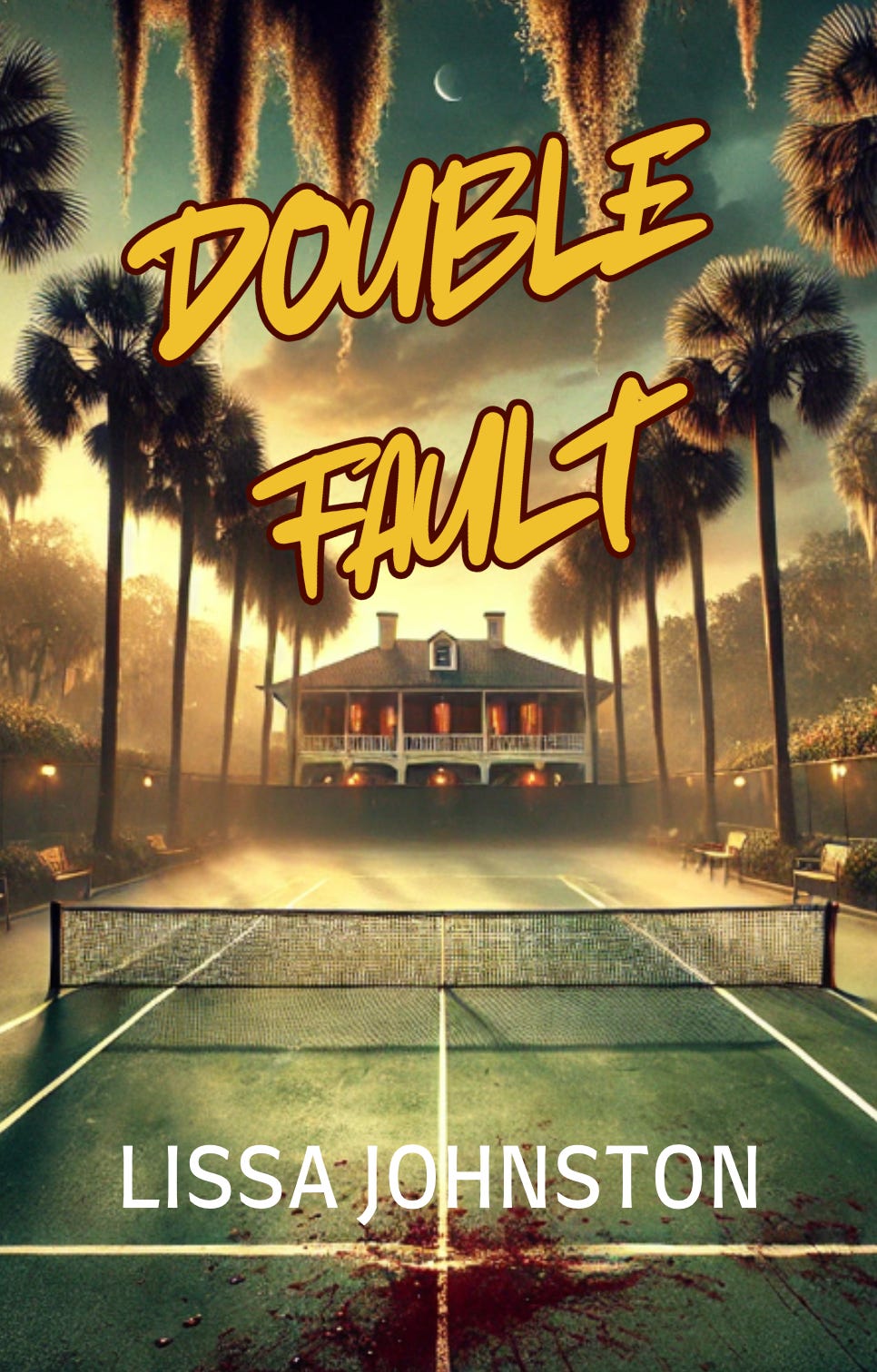Last night I stayed up late playing poker with Tarot cards. I got a full house and four people died. -Steven Wright
My latest novel, Ventured, includes a scene where a character is telling fortunes. While I don’t personally partake in fortune telling, I’ve always found the artwork on the cards very compelling.
As I was creating a TikTok about the fortune telling scene, the visuals of the tarot cards reminded me I also happen to own a deck of tarot-adjacent cards. They’re called Story Forge. It's a deck of cards you use in a myriad of ways to spur creativity, organize your writing, and generally have some fun.
The Story Forge cards are larger than your average playing card. They're more similar to a tarot card, very sturdy and well made. They come with a small instruction booklet. It took me just a few minutes to get the gist.
The set includes several suggestions on how the cards can be used. They have a couple different layouts, or 'spreads', for a book-length project. I shuffled the cards as best I could (they're quite stiff), and laid them out as suggested. Then I keyed them in to my Scrivener outline, and voila! in less than an hour I had a very workable outline.
Story Forge borrows from the master of story structure, Joseph Campbell. I merged my layout with Campbell's 12 Stages of the Hero's Journey, then plugged them into the Scrivener outline feature. As a secondary project, I played around with color coding and labeling each stage of the journey based on whichever card had popped up in the layout. The end result was a 22 step outline, complete with brief descriptions on what was supposed to be happening in each step and why. It's just a first draft. But a first draft of an outline for a complete novel in under an hour is pretty dang cool IMO.
You may be thinking this sounds a little too formulaic, but what book or movie isn't? In fact, the sociological research of Campbell and others indicates adhering to certain basic patterns contribute significantly to how much the reader/viewer enjoys the story. I figure, why mess with success? Rather than feel constrained, I feel comforted that Campbell is my guiding light so that I won't leave out any important components.
But back to the Story Forge cards: they can also be used for smaller projects. Here's an example of using them to flesh out a minor character. It requires only 7 cards.
Character 'Quick Pick'
Here's the layout, or spread:
The 88 cards are grouped into six different categories. The instructions explain the meanings of the categories, suggest some spreads, and indicate what each card position in the spread represents. Here are the results for helping develop a minor character, completely at random after a few shuffles. Since the writing is a little small in the picture, I've spelled it out for you below. The card number indicates its position in the layout. Directly below is a description of the card that landed in that position as I dealt them out.
Card 1: The character's base nature
WAR. Negotiations break down. No equitable solutions can be agreed upon. Conflict escalates to violent combat.
Card 2: The influence of the universe
THE BUREAUCRAT. As someone who accepts or even embraces bureaucracy, this person could be a powerful foe or ally in the political or financial arenas.
Card 3: His/her 'Achilles heel'
A WEALTH card. While wealth cards can be taken literally to represent money or finance, they can also stand for nearly anything in the physical, material world, including issues of shelter, employment or security.
Card 4: The influence of family/friends
RELAPSE. Forces or patterns that were thought to be left behind rise anew, stronger than ever.
Card 5: The character's driving passion
CHAOS. Chaos prevails. Rationality and predictability give way to random or seemingly insane events.
Card 6. The character's destiny
Another WEALTH card.
Card 7. What stands between them and their destiny
HEALTH. The body is strong and free from disease. Can be a generally good constitution or a return to health after having been injured or sick. Notice this 7th card is laid across the 6th. Crossing cards represent a barrier or obstacle to the card they are crossing. So in this instance, there is something about the health status of the character that is preventing them from achieving that second Wealth goal.
Obviously these spreads aren't going to make sense 100% of the time. No one is suggesting you become enslaved to them and try to make their suggestions work against the grain. If you turn up a card that doesn't work, there are several options. I don't know if you can see it in the photo, but each card has two meanings, usually opposite. For example, the bottom half of the Health card is Illness. If a card turns up that doesn't fit your needs, turn it around and try it that way. If it's still not working, draw another card. If the whole spread is a mess, reshuffle and try again.
Story Forge is just another way to get the creative juices flowing. I thoroughly enjoyed using it and will continue to do so, even though part of me keeps envisioning a scene from Tin Cup. If you haven't seen the movie, Kevin Costner plays a down-at-the-heels golf pro. Feeling some pressure about an upcoming tournament, he turns to some unusual training tools to help get back on track. He looked silly using them, but underneath all the nonsensical gear, he had some mad skills. I like to think we have that in common.
A version of this post originally appeared in October 2018.
I will leave you with three things.
For those of you who also live in Central Texas, I hope you will consider dropping in to the Smithville Coffee House and General Store in my little town. They have such a charming array of goods, great coffee/tea, baked goods, sandwiches, and even Blue Bell ice cream. And they’ve just partnered with the amazing Cheesy Sergeant food truck if you’re craving the cheesiest mac-n-cheese that ever cheesed.
I’m enjoying the heck out of fellow Substack author
’s posts. He cracks me up.
I’m always interested in books with a Texas theme. The Last Karankawas by Kimberly Garza fits the bill. As luck would have it, I read it not long after seeing this recent article in Texas Monthly. The infamous tribe inspired more than a few scenes in Ventured.
My latest book, Double Fault, is available now on Amazon.
When an investigation of illegal match fixing by the Russian mob brings the FBI to her tennis club in the person of hunky agent Wilson DuBois, Veronica Burk vows to help him solve the case quickly before her own very successful gambling habit falls under suspicion.
My historical fiction book, Ventured, is available now on Amazon.
When she takes a chance on making a new life for herself, French orphan and cutpurse extraordinaire Belle must find a way to survive in the New World—or she may not live long enough to enjoy it.
My YA trilogy is also still available if historical fiction isn’t your thing.
Brody Morgan grew up starring in commercials for his dad's mega food corporation. What will Brody do when he discovers what he's really been selling?










I love the idea of these cards. I haven't heard of them but we used a much simpler version when I was a teacher to help children get ideas for stories. For daily life, I have a deck of cards called Wisdom of the Oracle which I like using just for help with day to day problems. But perhaps I will get Story Forge to help with writing problems!
Wow, Lissa, we are on the same page this week. I just finished taking three classes on reading Tarot cards and I’m also about to start outlining the second book of my trilogy, but I have been lacking motivation to start. So, now I’m going to take a look at your guru’s outlining method and perhaps pull a few cards in the process. Thanks for the tips!